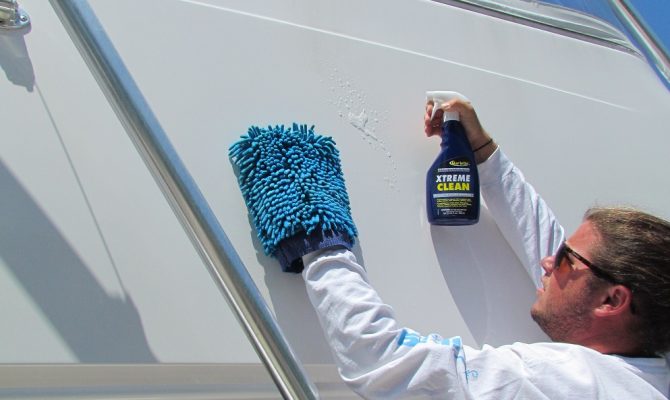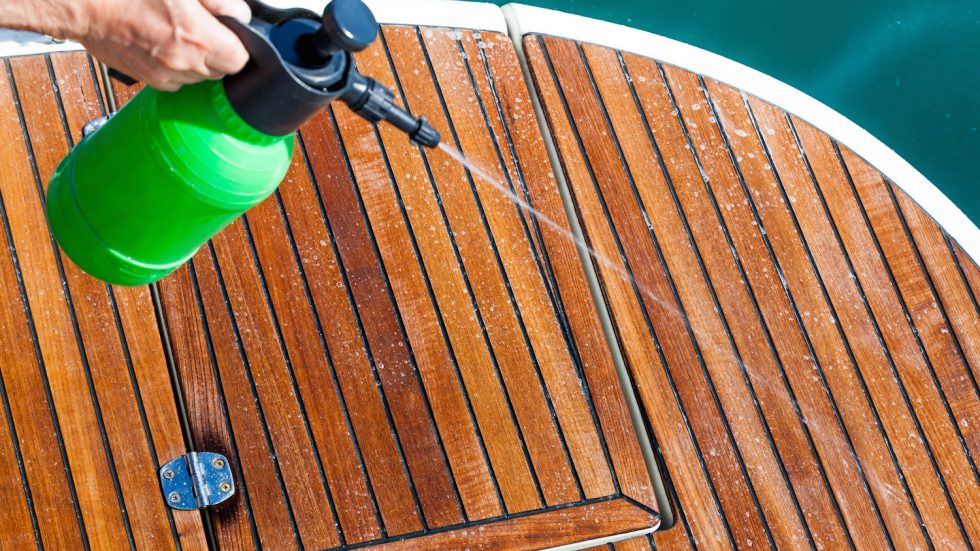In order to preserve and protect the gelcoat, it is vital not to be over aggressive and wear it away while trying to bring back that new boat luster. Knowing what to use to maintain the layer depends on its current condition.
Bill Lindsey, vice president of marketing for Star brite, a manufacturer of quality appearance and care products for boat, RV and other markets, says that gelcoat in its first five years of life is a very tight finish and reflects the light back, giving it a shiny look. As time goes by, and if it is not maintained, it becomes more porous and can result in a dull, chalky finish.
Lindsey says that in those first years a quality polymer finish will do a good job of sealing the gelcoat and maintaining its luster, while making dirt and contaminants clean easily from the surface. He recommends a polymer finish over carnauba-based waxes because it molecularly bonds with the gelcoat, creating a good durable seal, and suggests it will last longer and offer better long-term protection. Opposed to a three-month life of applied wax, Lindsey says that with diligent cleaning and the use of a spray detailer you can easily get eight months out of a polymer polish application. This short life of waxes is particularly true of carnauba waxes in warm weather and in a marine environment, where it will wear off.
Lindsey points out that there may come a time when, upon applying the polish, you see streaks or find it more difficult to apply evenly. When this occurs, a “cleaner wax” may be needed. (Lindsey says this name is a misnomer, as most cleaner waxes are made with polymers and not wax.) He explains that the difference between a polymer polish, which is more of a sealer, and a cleaner wax is that the latter will contain just a small amount of grit: “Just enough to get rid of light oxidation, swirl marks and scratches, but it is not even remotely as aggressive as a mild compound,” he said.
Lindsey says that unless the chalkiness is rubbing off on your fingers, you do not need to use a compound. Even then, a mild- or mid-grit compound is recommended. A couple of attempts may be required, and if at that point it is “still is not cutting it” (pun intended), then you may have to step up to a heavy-duty compound — but only as a last resort.
Application Process
The polish and cleaner wax can be applied by hand using applicator pads and then wiped off with clean microfiber or cotton cloths. When working larger areas, Lindsey says the job can go quicker and easier by applying the polish by hand and then removing it with a random orbital polisher.
He warns against using a rotary pad such as those that can be attached to a drill, as the heat generated from these have the potential to “burn” through the gelcoat. Once the compound has been applied and you get a nice, even shine, Lindsey recommends giving it a couple of days before applying the polymer sealer. He explains that in the compounding process, some of the “chaff” gets pushed back into the porous surface and it needs to work itself back out.
If it ends up blotchy, then a very light reapplication will fix it. If it still looks good and shiny at that point, then you can go ahead and put a polish on top. Lindsey recommends doing two coats to get the maximum shine, luster and protection. He points out that this is more work, but the second coat will go on much easier.
If you are particularly excessive about the finish and want to add depth (with dark colored hulls), then a layer of carnauba wax on top of the polish will give the hull a deep, satisfying luster. A product like Star brite’s Fiberglass Protectant and Paint Sealer is a specially formulated mixture of carnauba and polymer sealers that works exceptionally well for this final coat. You will need to repeat this final coat about every three months to maintain the deep luster.
Continuing maintenance of your newly detailed gelcoat is as easy as washing it regularly and using a spray detailer. Doing so will make your hard-earned finish last eight to 12 months. All your hard work will pay off with a protected gelcoat that’s easy to clean and will be the envy of those around you.
[author] [author_info]Glenn Hayes is a contributor to HeartLand Boating magazine.[/author_info] [/author]




